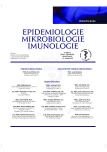Implementation and use of whole genome sequencing (WGS) in the surveillance of invasive pneumococcal disease, Czech Republic, 2017–2019
Authors:
J. Kozáková; M. Honskus; Z. Okonji
Authors‘ workplace:
Centrum epidemiologie a mikrobiologie, Státní zdravotní ústav, Praha
Published in:
Epidemiol. Mikrobiol. Imunol. 69, 2020, č. 3, s. 134-141
Category:
Original Papers
Overview
Aim: In order to improve the surveillance of invasive pneumococcal disease (IPD), the National Reference Laboratory (NRL) for Streptococcal Infections implemented whole genome sequencing (WGS) of Streptococcus pneumoniae. This article reports the first WGS data on S. pneumoniae isolates in the Czech Republic.
Material and Methods: Thirty-five isolates of S. pneumoniae from IPD recovered in 2017–2019 were selected for WGS. These were serotypes 4, 8, 9V, 19A, and 22F, which were determined by the Quellung reaction in combination with endpoint multiplex PCR (mPCR). Multilocus sequence typing (MLST) is routinely used for more detailed analysis termed sequence typing. The selected isolates were analysed by WGS on the Illumina MiSeq platform. The sequences obtained were processed using the Velvet de novo Assembler software. The assembled genomes were uploaded into the PubMLST database, using the BIGSdb platform, and then scanned automatically and molecularly characterized. The isolates were compared at three resolution levels: seven MLST genes, 53 ribosomal genes (rMLST), and 1420 genes (all loci). The all loci scheme covers MLST genes, ribosomal genes, and core genome MLST genes (cgMLST). These are all currently defined genes of S. pneumoniae available in the PubMLST database. Distance matrices based on the number and variability of all loci analysed were generated automatically using the Genome Comparator tool. Phylogenetic networks were created and edited with the SplitsTree4 package, using the NeighborNet algorithm. The final graphics were edited with the Inkscape software.
Results: Based on an overall view of the phylogenetic networks, it can be concluded that the genetic lines within each of S. pneumoniae serotypes 4, 8, 9V, 19A, and 22F are highly unrelated, to the same extent as if the isolates were of different serotypes. S. pneumoniae isolates of the same serotype, whether or not of the same sequence type, can be described, based on the results, as a non-homogeneous group with a number of unrelated genetic clusters that share genes assigning them to a specific serotype. WGS has also shown its discriminatory power, allowing the assignment of isolates of the same serotype and sequence type to different genetic clusters.
Conclusion: Of the methods used so far in the Czech Republic, WGS allows the most detailed characterization of S. pneumoniae isolates. It is highly desirable to integrate it in the molecular surveillance of IPD in the Czech Republic, similarly to other countries in Europe and in the world.
Keywords:
Streptococcus pneumoniae – MLST – serotype – WGS – whole genome sequencing – genomic surveillance – sequence type
Sources
1. Vyhláška č. 275/2010 Sb., kterou se mění vyhláška č. 473/2008 Sb., o systému epidemiologické bdělosti pro vybrané infekce, příloha č. 21 invazivní pneumokoková onemocnění.
2. Vacková Z, Klímová M, Kozáková J. Nová metoda a schéma typi-zace Streptococcus pneumoniae. Epidemiol Mikrobiol Imunol, 2013;62(2):50–58.
3. Enright MC, Spratt BG. A multilocus sequence typing scheme for Streptococcus pneumoniae: identification of clones associated with serious invasive disease. Microbiology, 1998;144:3049–3060.
4. Revez J, Espinosa L, Albiger B, et al. Survey on the Use of Whole-Genome Sequencing for Infectious Diseases Surveillance: Rapid Expansion of European National Capacities, 2015–2016. Front Public Health, 2017;5:347. DOI: 10.3389/fpubh.2017.00347.
5. Kozáková J, Okonji Z, Šebestová H, Klímová M, Křížová P. Invazivní pneumokokové onemocnění v České republice v roce 2018. Zprávy CEM (SZÚ, Praha), 2019;28(7):277–282.
6. https://tessy.ecdc.europa.eu/tessyweb.
7. https://pubmlst.org/spneumoniae/.
8. Manuál QIAamp DNA Mini Kit. Dostupné na www: http://www.qiagen.com/Products/Catalog/Sample-Technologies/DNA-Sample-Technologies/Genomic-DNA/QIAamp-DNA-Mini-Kit#technicalspecification
9. Zerbino DR. Using the Velvet de novo assembler for short-read sequencing technologies. Curr Protoc Bioinformatics, 2010;11(11.5). DOI: 10.1002/0471250953.bi1105s31.
10. Jolley KA, Maiden MCJ. BIGSdb: Scalable analysis of bacterial genome variation at the population level. BMC Bioinformatics, 2010;11(595). DOI: 10.1186/1471-2105-11-595.
11. Maiden MCJ, Bygraves JA, Feil E, et al. Multilocus sequence ty-ping: A portable approach to the identification of clones within populations of pathogenic microorganisms. Proc Natl Acad Sci U S A, 1998;95(6):3140–3145.
12. Jolley KA, Bliss CM, Bennett JS, et al. Ribosomal multilocus sequence typing: universal characterization of bacteria from domain to strain. Microbiology, 2012;158(4):1005-15. DOI: 10.1099/mic.0.055459-0.
13. Kozáková J, Okonji Z, Musílek M. Klonální charakterizace kmenů Streptococcus pneumoniae metodami MLST a MLVA – může metoda MLVA charakterizaci zkvalitnit? Epidemiol Mikrobiol Imunol, 2020;69(1):20–28.
14. Mauffrey F, Fournier É, Demczuk W, et al. Comparison of sequential multiplex PCR, sequetyping and whole genome sequencing for serotyping of Streptococcus pneumoniae. PLoS One, 2017;12(12):e0189163. DOI: 10.1371/journal.pone.0189163.
15. Demczuk WHB, Martin I, Hoang L, Van Caeseele P, et al. Phylogenetic analysis of emergent Streptococcus pneumoniae serotype 22F causing invasive pneumococcal disease using whole genome sequencing. PLoS One, 2017;12(5):e0178040. DOI: 10.1371/journal.pone.0178040.
16. Sheppard CL, Groves N, Andrews N, et al. The Genomics of Streptococcus Pneumoniae Carriage Isolates from UK Children and Their Household Contacts, Pre-PCV7 to Post-PCV13. Genes (Basel), 2019;10(9):687. DOI: 10.3390/genes1009068
Labels
Hygiene and epidemiology Medical virology Clinical microbiologyArticle was published in
Epidemiology, Microbiology, Immunology

2020 Issue 3
Most read in this issue
- Epidemiology of vancomycin-resistant enterococci in the Hradec Králové University Hospital in 2017
- Drain fly – Clogmia albipunctata (Diptera: Psychodidae) – a fly with epidemiological potential and posing risk of myiasis
- The duration of SARS-CoV-2 shedding in patients recovering from COVID-19
- Seroprevalence of IgG antibodies against measles in health care workers of the Strakonice Hospital
